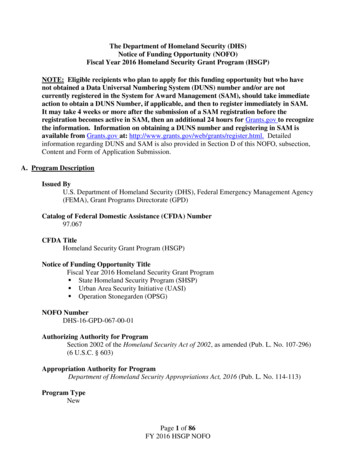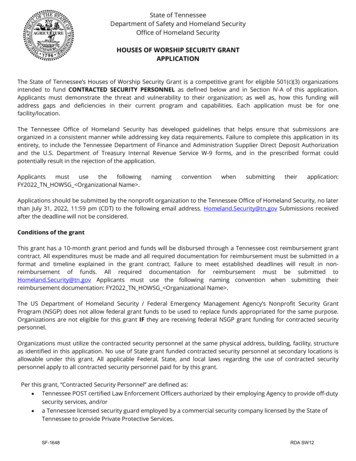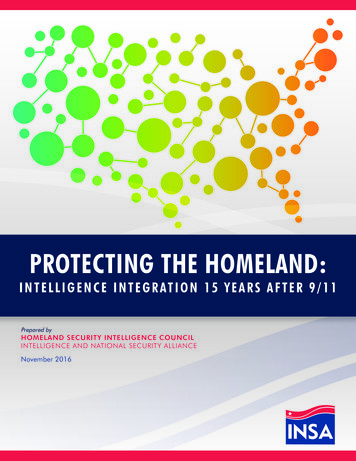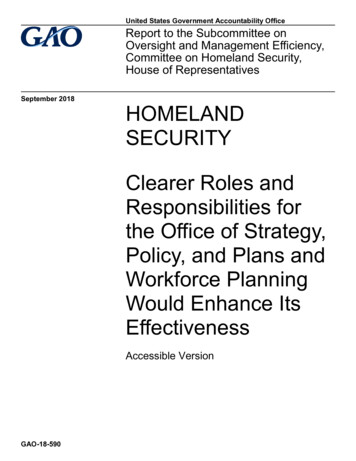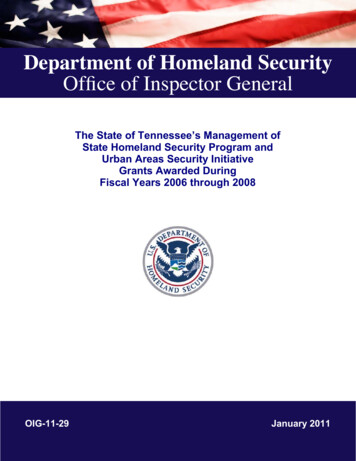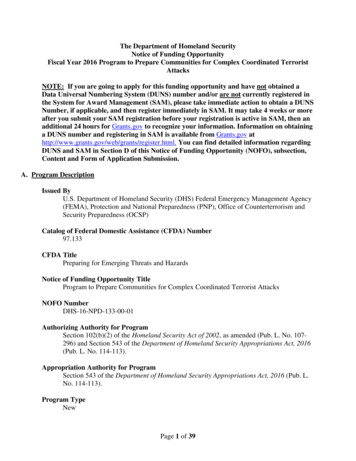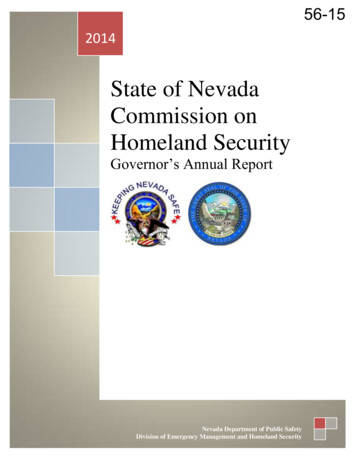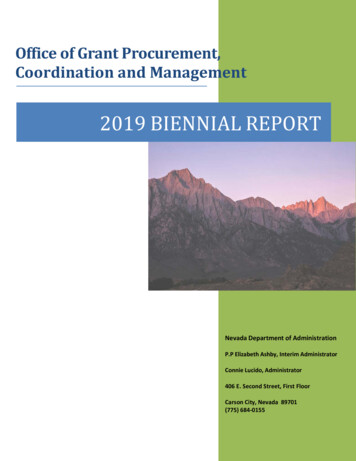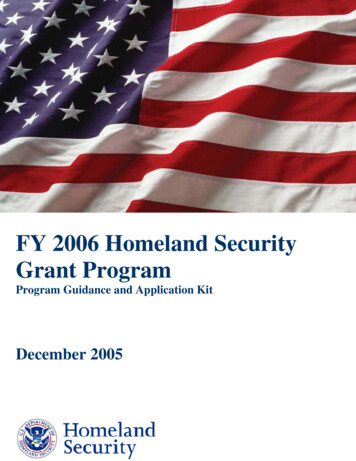
Transcription
FY 2006 Homeland SecurityGrant ProgramProgram Guidance and Application KitDecember 2005
DisclaimerThe views and opinions of authors of reference materials expressed herein do not necessarilyreflect those of the United States Government.Reference within this document to any specific commercial products, processes, or services bytrade name, trademark, manufacturer, or otherwise does not necessarily constitute or imply itsendorsement, recommendation, or favoring by the United States Government.The information and statements contained within this document shall not be used for thepurposes of advertising, nor to imply the endorsement or recommendation of the United StatesGovernment.With respect to any other information contained within non-DHS documents or referencematerials referred to within this guidance, neither the United States Government nor any of itsemployees make any warranty, express or implied, including but not limited to the warranties ofmerchantability and fitness for a particular purpose. Further, neither the United StatesGovernment nor any of its employees assume any legal liability or responsibility for theaccuracy, completeness, or usefulness of any information, apparatus, product or processdisclosed; nor do they represent that its use would not infringe privately owned rights.i
FOREWORDOn October 18, 2005, the President signed the Department of Homeland Security (DHS)Appropriations Act of 2006, providing vital funding needed to ensure the safety and security ofour homeland. Through the DHS Preparedness Directorate’s Office of Grants and Training(G&T) (formerly the Office of State and Local Government Coordination and Preparedness(SLGCP)), State and local organizations will receive approximately 2.5 billion in grant fundingto build capabilities that enhance homeland security.DHS is charged with maximizing the security of our homeland. We must prioritize our effortsbased on risk, and we must invest wisely to ensure timely and effective improvement. Inrecognition of this reality, the FY 2006 Homeland Security Grant Program (HSGP) outlines aprioritized approach to funding allocations with an emphasis on risk and need.This year marks the first grant cycle in which we have a National Preparedness Goal to shapeNational Priorities and focus expenditures. This common planning framework and the tools thatsupport it allows us as a Nation to better understand how prepared we are, how prepared we needto be, and how we prioritize efforts to close that gap.As in previous fiscal years, the FY 2006 HSGP continues to provide funding for planning,organization, equipment, training, exercises, and management and administration to prevent,protect against, respond to, and recover from terrorist attacks, major disasters, and otheremergencies in all 50 States, the District of Columbia, the Commonwealth of Puerto Rico, andthe U.S. Territories. States and Territories will now have the opportunity to implement theirrecently updated Homeland Security Strategies and continue to improve upon existingcapabilities.The Department recognizes that implementing the National Preparedness Goal is a long-termendeavor. We remain committed to working with States and Urban Areas to build and enhancepreparedness capabilities in the coming years.The FY 2006 HSGP reflects the Department’s commitment to work closely with the Nation’shomeland security stakeholders in a unified national effort to address terrorist attacks, majordisasters, and other emergencies and enhance the security of our homeland.Michael ChertoffSecretaryDepartment of Homeland Securityii
Table of ContentsI.National Preparedness. 1II.Program Guidance. 16III.Eligible Applicants and Funding Availability . 52IV.Application Kit . 57V.Award and Reporting Requirements . 63VI.State Homeland Security Program. 69VII.Urban Areas Security Initiative. 76VIII. Law Enforcement Terrorism Prevention Program . 87IX.Metropolitan Medical Response System. 94X.Citizen Corps Program. 106Appendix A – Sample Award Package . A-1Appendix B – Investment Justification . B-1Appendix C – Memorandum of Understanding Template . C-1Appendix D – Allowable Cost Matrix . D-1Appendix E – Historical Allowable Data . E-1Appendix F – Relationship of Grant Programs to Target Capabilities.F-1Appendix G – NIMS State, Territorial and Tribal Compliance Activities .G-1Appendix H – Geospatial Guidance .H-1Appendix I – Cyber Security Guidance . I-1Appendix J – Domestic Nuclear Detection Office (DNDO) . J-1Appendix K – Public Safety Communications & Interoperability guidance .K-1Appendix L – Web Resources. L-1Appendix M – Acronyms. M-1Appendix N – Index . N-1iii
Table of FiguresFigure 1 – Target Capabilities . 12Figure 2 – Process Overview. 14Figure 3 – Relationship of Initiatives to Goals, Objectives, Investments, and Projects . B-2Figure 4 – Interoperable Communications as a Priority, Capability, Strategic Goal,Initiative and Investment, and Project. B-2Table of TablesTable 1 – FY 2006 Homeland Security Grant Program. 16Table 2 – Other FY 2006 Office of Grants and Training Grant Programs. 17Table 3 – FY 2006 Other Preparedness Grant Programs. 19Table 4 – FY 2005 DHS/HHS Preparedness Programs. 20Table 5 – POETE and the Elements of Capability . 31Table 6 – MMRS Jurisdictions . 54Table 7 – Application Checklist. 57Table 8 – SHSP Allowable Equipment Categories . 73Table 9 – UASI Allowable Equipment Categories. 84Table 10 – LETPP Allowable Equipment Categories . 90Table 11 – MMRS Allowable Equipment Categories. 102Table 12 – CCP Allowable Equipment Categories . 110Table 13 – FY 2006 Allowable Cost Matrix. D-1Table 14 – Historical Planning Categories . E-1Table 15 – Historical Equipment Costs . E-1Table 16 – Historical Training Costs . E-2Table 17 – Historical Exercise Costs . E-3Table 18 – Historical Management & Administrative Costs . E-3Table 19 – Relationship of Grants to Target Capabilities.F-1Table 20 – NIMS Implementation Matrix for States and Territories.G-4Table 21 – NIMS Implementation Matrix for Tribal and Local Jurisdictions .G-15Table 22 – Minimum (“no worse than”) Goals for Resolution, Accuracy, and Currency.H-3Table 23 – TA for RAD/NUC Preventive Detection Programs . J-2iv
FY 2006 Homeland Security Grant Program (HSGP) Guidance RevisionsLocationJanuary 3, 2006SectionChangePg. 45, 1st Bulletunder UnauthorizedExercise CostsChapter II: Program Guidance; SectionD – Allowable Cost Guidance;Subsection D.5. – Exercises,Unauthorized Exercise CostsAdded mileage to fuel/gasoline as the onlyvehicle costs that are reimbursable.Pg. 54, 2nd ParagraphChapter III: Eligible Applicants andFunding Availability; Section C –Funding; Subsection C.1. – FY 2006SHSP and LETPP AllocationsDeleted “UASI” from the first sentence.UASI will not be allocated using the USAPATRIOT Act formulaPg. 58, 6th ParagraphChapter IV: Application Kit, Section 3 –For identified UASI Urban Areas, 1stBulletReplaced 2nd sentence for clarityPg. 59, 1st ParagraphChapter IV: Application Kit, Section 3 –For identified UASI Urban Areas, 2ndBulletReplaced 2nd sentence for clarityPg. 59, 3rd ParagraphChapter IV: Application Kit, Section 3 –For identified UASI Urban Areas, 3rdBulletReplaced 1st sentence for clarityPg. 78, 1st ParagraphChapter VII: Urban Areas SecurityInitiative; Section B – ProgramRequirements, GovernanceRevised governance discussion related toUrban Area Working Groups (UAWG)Pg. 79, 1st ParagraphChapter VII: Urban Areas SecurityInitiative; Section B – ProgramRequirements, Defining Urban AreasUrban Area definition requirementslanguage updated for clarityPg. 79, 3rd Paragraph,2nd BulletChapter VII: Urban Areas SecurityInitiative; Section B – ProgramRequirements, Defining Urban Areas,3rd Paragraph, 2nd BulletChapter VIII: Law EnforcementTerrorism Prevention Program; SectionC – Authorized Program Expenditures;Subsection C.7. – Management andAdministrationRevised language for clarityPg. 92, 2nd ParagraphvDeleted “UASI” and replaced it with“LETPP” in the discussion of M&A costsassociated with the LETPP program
I. NATIONALPREPAREDNESS
FY 2006 HOMELAND SECURITY GRANT PROGRAM – DECEMBER 2, 2005I.NATIONAL PREPAREDNESSA.The FY 2006 Homeland Security Grant ProgramSeveral significant changes in the HSGP and its focus are being made for FY 2006. First, thismarks the first grant cycle in which the Interim National Preparedness Goal is in place to outlineNational Priorities and focus expenditures on building capabilities. This common planningframework and the tools that support it allow the Nation to define target levels of performanceand measure progress made toward achieving them. In addition, the Department of HomelandSecurity (DHS) is adopting in FY 2006 a risk- and need-based approach to allocating funding forcertain programs within HSGP. The aim is to allocate and apply these resources to generate thehighest return on investment and, as a result, strengthen national preparedness in the mosteffective and efficient manner. In addition to integrating these new policy developments, the FY2006 HSGP guidance: Highlights the Interim National Preparedness Goal and its applicability to the FY 2006HSGP Highlights the Target Capabilities List and its applicability to the FY 2006 HSGP Presents overall FY 2006 HSGP policy and program requirements, including overall FY2006 HSGP allowable costs Guides grantees in the application and awardThe National Preparedness Goal:process for the FY 2006 HSGPTo achieve and sustain risk-based Provides detail on the specific requirementstarget levels of capability toassociated with FY 2006 SHSP, UASI, LETPP,prevent, protect against, respondMMRS, and CCPto, and recover from major events,and to minimize their impact onB.The National Preparedness Goallives, property, and the economy,through systematic and prioritizedOn March 31, 2005, DHS issued the Interim Nationalefforts by Federal, State, local andPreparedness Goal (the Goal). The Goal establishes aTribal entities, their private andvision for National Preparedness including Nationalnon-governmental partners, and thePriorities. The Target Capabilities List (TCL)general public.1The Emergency Management Performance Grant (EMPG) Program was included in the FY 2005 HSGPapplication, however in FY 2006, EMPG was released as a stand-alone application earlier in the fiscal year.PREPAREDNESS DIRECTORATE’S OFFICE OF GRANTS AND TRAINING1NATIONAL PREPAREDNESSThe FY 2006 Homeland Security Grant Program (HSGP) integrates the State Homeland SecurityProgram (SHSP), the Urban Areas Security Initiative (UASI), the Law Enforcement TerrorismPrevention Program (LETPP), the Metropolitan Medical Response System (MMRS), and theCitizen Corps Program (CCP). This combined FY 2006 HSGP Program Guidance andApplication Kit builds upon the FY 2005 HSGP to streamline efforts for States and Urban Areasin obtaining resources that are critical to building and sustaining capabilities to achieve theInterim National Preparedness Goal (the Goal) and implement State and Urban Area HomelandSecurity Strategies.1
FY 2006 HOMELAND SECURITY GRANT PROGRAM – DECEMBER 2, 2005The Goal and the TCL are all-hazard in nature, addressing a range of major events, includingterrorism and the capabilities required to address them. However, the five programs included inthe HSGP do not support all elements within each capability in the TCL. A number of additionalresources at different levels of government are available and should be leveraged to build andsustain capabilities. For example, the Triage and Pre-Hospital Treatment Capability of the TCLrecommends sufficient numbers of certified/licensed emergency medical service (EMS)personnel; however, the costs associated with hiring those personnel are not allowable underHSGP.The Goal encompasses the full spectrum of activities necessary to address the entire range ofthreats and hazards. In addition to a number of common activities that support preparedness(e.g., planning, interoperable communications, risk management, and citizen preparedness andparticipation), four mission areas help create a framework for developing the subset of nationalcapabilities that will be supported by DHS preparedness grant program funding. Somecapabilities fall outside the scope of HSGP funding and are the responsibility of other Federalagencies or State and local governments. The four mission areas are prevent, protect, respond,and recover. As stated in NIMS, mitigation activities are important elements of preparednessand provide a critical foundation across the spectrum from prevention through recovery. Themission areas are discussed in further detail below.Prevent: Actions to avoid an incident or to intervene to stop an incident from occurring.Prevention involves intelligence and deterrence operations; heightened inspections; improvedsurveillance and security operations; investigations; education and training; enhanced nuclearand radiological detection capabilities; public health and agricultural surveillance and testingprocesses; immunizations, isolation, or quarantine; and certain law enforcement operations.32This guidance references 37 capabilities based on the most recent draft of the TCL available at the time theguidance went to press.3NIMS, March 2004.PREPAREDNESS DIRECTORATE’S OFFICE OF GRANTS AND TRAINING2NATIONAL PREPAREDNESSidentifies 37 capabilities integral to Nation-wide all-hazards preparedness, including acts ofterrorism.2 The national preparedness doctrine and operational foundation provided in thesedocuments form the basis for Federal preparedness assistance going forward. The Goal is asignificant evolution in the approach to preparedness and homeland security. It presents acollective vision for national preparedness, and establishes National Priorities to guide therealization of that vision to meet the most urgent needs. The Goal is a companion document tothe National Response Plan (NRP), National Incident Management System (NIMS), and theinterim National Infrastructure Protection Plan (NIPP). The Goal establishes a framework thatguides entities at all levels of government in the development and maintenance of the capabilitiesto prevent, protect against, respond to, and recover from major events, including Incidents ofNational Significance as defined in the NRP.[1] Additionally, the Goal will assist entities at alllevels of government in the development and maintenance of the capabilities to identify,prioritize, and protect critical infrastructure and key resources as described in the NIPP. Risk andcapability-based planning for prioritizing homeland security investments shall be performedpursuant to the final National Preparedness Goal following its expected release soon after the FY2006 HSGP guidance.
FY 2006 HOMELAND SECURITY GRANT PROGRAM – DECEMBER 2, 2005Public announcements, infrastructure improvements and citizen vigilance also are important,especially when considering an all-hazards approach.Respond: Activities that address the short-term, direct effects of an incident. Response includesimmediate actions to save lives, protect property, and meet basic human needs. As indicated bythe situation, response activities include: applying intelligence and other information to lessenthe effects or consequences of an incident; increasing security and law enforcement operations;continuing investigations into the nature and source of the threat; continuing ongoing publichealth and agricultural surveillance and testing processes; providing immunizations; enforcingisolation or quarantine; and allowing appropriate citizen response.6 A prepared community willalso possess sufficient capability for emergency feeding and sheltering of displaced personnel.Recover: The development, coordination, and execution of service- and site-restoration plans;the reconstitution of government operations and services; individual, private-sector,nongovernmental, and public-assistance programs to provide housing and to promote restoration;long-term care and treatment of affected persons; additional measures for social, political,environmental, and economic restoration; evaluation of the incident to identify lessons learned;post-incident reporting; and development of initiatives to mitigate the effects of future incidents.7Each mission area includes a collection of capabilities that require integration and collaborationacross multiple disciplines, jurisdictions, levels of government, processes, and procedures. Manyof these capabilities support the achievement of the National Priorities listed in the Goal.The Goal and the TCL are evolving documents that will be updated regularly to incorporate newthreats, technologies, improvements to capability levels, new preparedness initiatives andpriorities, and lessons-learned. DHS will coordinate the establishment of a structure and processfor the ongoing management and maintenance of the Goal. This structure and process will becoordinated closely with the ongoing management and maintenance of the NIMS, NRP, andNIPP. Such coordination will ensure that national policy and planning for operations andpreparedness are mutually supportive.The Nation’s priorities, target levels, and performance metrics within the TCL shall be modifiedto reflect the completion or update of assessments, and shall include benchmarks for measuring4Homeland Security Presidential Directive (HSPD) 7, December 2003.The National Strategy for the Physical Protection of Critical Infrastructures and Key Assets, February 2003.6NIMS, March 2004.7NIMS, March 2004.5PREPAREDNESS DIRECTORATE’S OFFICE OF GRANTS AND TRAINING3NATIONAL PREPAREDNESSProtect: Actions to reduce the vulnerability of critical infrastructure or key resources in order todeter, mitigate, or neutralize terrorist attacks, major disasters, and other emergencies.4 Protectionalso includes: continuity of government and operations planning; evacuation planning, awarenesselevation and understanding of threats and vulnerabilities to related critical facilities, systems,and functions; promotion of effective sector-specific protection practices and methodologies; andexpansion of voluntary security-related information sharing between government and privateentities.5
FY 2006 HOMELAND SECURITY GRANT PROGRAM – DECEMBER 2, 2005the achievement of unmet capabilities over time. Additional foreseeable changes to thedocuments and their implementation shall include: Recommendations and lessons learned from the response to Hurricane Katrina identifiedby the Comprehensive Review Working Group (CRWG).Revisions to the National Response Plan.Capabilities required for implementing the National Infrastructure Protection Plan.Capabilities required for implementing the National Strategy for Pandemic Influenza.Prevention tasks and capabilities identified by updated National Planning Scenarios andreflective of current Administration policies on the War on Terror.State and local governments and public safety entities are encouraged to participate in themaintenance process by submitting questions and comments related to its implementation.National PrioritiesThe National Priorities in the Goal help guide the Nation’s preparedness efforts to meet its mosturgent needs. The priorities fall into two categories: (A) three overarching priorities thatcontribute to the development of multiple capabilities, and (B) four capability-specific prioritiesthat build selected capabilities for which the Nation has the greatest need. The following sectionoutlines each of the National Priorities as well as critical benchmarks developed to assist DHSand grantees in demonstrating progress made toward achieving the National Priorities. The threeoverarching priorities include:C.1.Expanded Regional CollaborationMajor events, especially terrorism, will invariably have cross-geographic consequences andimpact. The Expanded Regional Collaboration Priority highlights the need for embracingpartnership across multiple jurisdictions, regions, and States in building capabilitiescooperatively. Successful regional collaboration allows for a multi-jurisdictional and multidisciplinary approach to building capabilities for all four mission areas, spreading costs, andsharing risk across geographic areas. This approach increases efficiency and leveragecapabilities. Regional collaboration focuses on expanding mutual aid and assistance compactsamong contiguous State, local, and Tribal entities, and their private and non-governmentalpartners, and extending the scope of those compacts to include pre-incident preparednessactivities (e.g., planning, training, exercising). The intent is to tactically locate capabilities inorder to maximize coverage of the U.S. population and the Nation’s high priority criticalinfrastructure and key resources. The Goal establishes as a priority the embracing of regionalapproaches to building, sustaining, and sharing capabilities at all levels of government.Benchmarks for implementation of this National Priority include: Formalize mutual aid agreements with surrounding communities and States for thepurposes of sharing equipment, personnel, and facilities during emergencies.Exercise the execution of mutual aid agreements to identify challenges and familiarizeofficials with resources that are available in the region.PREPAREDNESS DIRECTORATE’S OFFICE OF GRANTS AND TRAINING4NATIONAL PREPAREDNESSC.
FY 2006 HOMELAND SECURITY GRANT PROGRAM – DECEMBER 2, 2005 Coordinate homeland security preparedness assistance expenditures and planning effortson a regional basis to avoid duplicative or inconsistent investments.During FY 2006 and FY 2007, DHS will continue to review progress on several ongoingregional collaboration efforts, including: C.2.Progress made by Urban Area Working Groups under the UASI program with regard toimplementing the vision, goals, and objectives outlined in the Urban Area HomelandSecurity Strategies.Progress on Regional Transit Security Strategy Working Group structure supported bythe Transit Security Grant Program (TSGP), under which State, local, Tribal, and parishleadership joined the respective transit leadership to coordinate a collective approach tomanaging the needs of the eligible transit grant recipients in concert with the balance ofthe transportation providers for that region.Implement the NIMS and NRPHomeland Security Presidential Directive-5 (HSPD-5), “Management of Domestic Incidents,”mandated the creation of NIMS and NRP. The NRP establishes a comprehensive all-hazardsapproach to managing domestic incidents. The plan incorporates best practices and proceduresfrom incident management disciplines – homeland security, emergency management, lawenforcement, firefighting, public works, public health, responder and recovery worker health andsafety, emergency medical services, and the private sector – and integrates those best practicesand procedures into a unified structure. The NIMS provides a consistent framework for entitiesat all jurisdictional levels to work together to implement the NRP and manage domesticincidents, regardless of cause, size, or complexity. To promote interoperability and compatibilityamong Federal, State, local, and Tribal capabilities, the NIMS includes a core set of guidelines,standards, and protocols for command and management, preparedness, resource management,communications and information management, supporting technologies, and management andmaintenance of NIMS. The NRP, using the template established by the NIMS, is an alldiscipline, all-hazards plan that provides the structure and mechanisms to coordinate operationsfor evolving or potential Incidents of National Significance. Based on the criteria established inHSPD-5, Incidents of National Significance are those high-impact events that require acoordinated and effective response by an appropriate combination of Federal, State, local, Tribal,private sector, and nongovernmental entities in order to save lives, minimize damage, andprovide the basis for long-term community recovery and mitigation activities. DHS and otherFederal agencies are currently reviewing implementation of the NRP during Hurricanes Katrinaand Rita.The implementation of the NIMS within every State, Territory, Tribal, and local jurisdictioncreates a common framework and system that, once established nationwide, will be thefoundation for prevention, protection, response, and recovery operations. Full NIMSimplementation is a dynamic and multi-year phase-in process with important linkages to theNRP, Homeland Security Presidential Directive - 8 (i.e., the Goal) and the interim NIPP. TheNIMS Integration Center (NIC) will continue to work with Federal Departments and agencies toensure Federal implementation of NIMS and that all FY 2006 Federal preparedness assistancePREPAREDNESS DIRECTORATE’S OFFICE OF GRANTS AND TRAINING5NATIONAL PREPAREDNESS
FY 2006 HOMELAND SECURITY GRANT PROGRAM – DECEMBER 2, 2005programs reflect and support NIMS implementation at the State, local, and Tribal governmentsas appropriate.State, local, and Tribal entities are required to become fully compliant with NIMS by the end ofFY 2006 (September 30, 2006). Entities are required to meet the FY 2006 NIMSimplementation requirements as a condition of receiving Federal preparedness funding assistancein FY 2007. States and Territories must establish a planning process that incorporates theappropriate procedures to ensure the effective communication and implementation of NIMSrequirements across the State, including Tribes and local governments. This planning processmust include a means for measuring progress and facilitate the reporting of NIMSimplementation among its Tribal and local jurisdictions. Office of Grants and Training (G&T)will continue to update grantees on NIMS compliance measures as they become available. State, local, and Tribal entities should be fully compliant with NIMS by the end of FY2006 (September 30, 2006). As part of this compliance, States and Territories mustinstitute the planning process called for in the September 2005 letter to Governors toensure effective communication and implementation of NIMS requirements across theState, including Tribes and local governments.Progress toward the additional steps that State, Territorial, Tribal, and local entitiesshould take during FY 2006 to become fully compliant with the NIMS, as outlined in theFY 2006 NIMS Implementation Matrices, included as Appendix G.For FY 2007, compliance with NIMS implementation requirements will be a condition ofreceiving Federal preparedness fun
A. The FY 2006 Homeland Security Grant Program The FY 2006 Homeland Security Grant Program (HSGP) integrates the State Homeland Security Program (SHSP), the Urban Areas Security Initiative (UASI), the Law Enforcement Terrorism Prevention Program (LETPP), the Metropolitan Medical Response System (MMRS), and the Citizen Corps Program (CCP).
